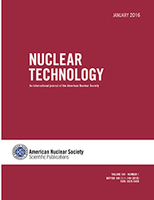
NUCLEAR TECHNOLOGY
Scope & Guideline
Transforming Knowledge into Nuclear Solutions
Introduction
Aims and Scopes
- Nuclear Reactor Physics and Design:
Research in this area focuses on neutron transport, reactor dynamics, and the development of advanced reactor designs, including small modular reactors (SMRs) and molten salt reactors (MSRs). It addresses criticality safety, fuel cycle analysis, and the application of computational methods for reactor simulation. - Thermal-Hydraulic Analysis:
This scope covers the study of heat transfer, fluid dynamics, and system behavior under various operational conditions in nuclear reactors. It includes modeling and simulation of thermal-hydraulic phenomena, safety assessments, and the development of new cooling technologies. - Nuclear Materials and Fuel Cycles:
Research involving the development and characterization of nuclear fuels, including advanced materials for high-temperature reactors and the recycling of spent fuels. This includes studies on actinide management, corrosion resistance, and the performance of new fuel forms. - Nuclear Safety and Risk Assessment:
This area emphasizes methodologies for the assessment of nuclear safety, including probabilistic risk assessment (PRA), human factors engineering, and safety culture in nuclear facilities. It aims to improve safety protocols and regulatory frameworks. - Nuclear Waste Management and Disposal:
Research focused on the handling, treatment, and long-term storage of nuclear waste. This includes studies on geological disposal, waste form development, and the environmental impact of nuclear materials. - Radiation Detection and Measurement:
Development of advanced detection technologies and methodologies for measuring radiation in various contexts, including nuclear power plants, medical applications, and environmental monitoring. - Nuclear Applications in Space and Advanced Propulsion:
Exploration of the use of nuclear technology for space applications, including power generation for deep space missions, nuclear thermal propulsion systems, and the development of radioisotope power systems. - Cybersecurity in Nuclear Facilities:
Research addressing the cybersecurity challenges faced by nuclear facilities, focusing on the protection of critical infrastructure from cyber threats and the implementation of secure digital systems.
Trending and Emerging
- Advanced Reactor Technologies:
There is a notable increase in research focused on innovative reactor designs, particularly small modular reactors (SMRs) and high-temperature gas reactors (HTGRs). These technologies promise enhanced safety, efficiency, and adaptability to various energy demands. - Machine Learning and AI Applications in Nuclear Engineering:
The incorporation of machine learning and artificial intelligence in nuclear technology is on the rise. Researchers are exploring AI for predictive maintenance, anomaly detection, and optimization of reactor operations, which signifies a transformative shift in operational methodologies. - Nuclear Cybersecurity:
As the digital landscape evolves, there is a growing emphasis on cybersecurity within nuclear facilities. Research is increasingly focused on developing robust security frameworks to protect against cyber threats, ensuring the integrity of nuclear operations. - Sustainable Nuclear Fuel Cycles:
Emerging studies are concentrating on sustainable fuel cycles, including the recycling of spent fuels and the development of advanced fuels, which align with global efforts to enhance the sustainability of nuclear energy. - Environmental Impact and Safety Assessments:
Research that assesses the environmental impacts of nuclear technologies, including life cycle analyses and safety assessments for new reactor designs, is gaining momentum, reflecting heightened regulatory and public scrutiny. - Remote and Autonomous Operation Technologies:
The development of remote monitoring systems and autonomous technologies for nuclear operations is becoming increasingly relevant, driven by the need for improved safety, efficiency, and response capabilities in nuclear facilities.
Declining or Waning
- Historical and Legacy Studies:
Research centered on historical nuclear events, such as the Manhattan Project, has decreased in frequency. This trend suggests a shift towards more contemporary issues and technological advancements rather than retrospective analyses. - Conventional Reactor Designs:
Studies focusing on traditional large-scale light water reactors have become less prominent, possibly due to the increasing interest in innovative reactor designs such as SMRs and advanced reactors that offer enhanced safety and efficiency. - Basic Nuclear Physics:
Papers that delve into fundamental nuclear physics concepts and theories have seen a decline, as the journal appears to prioritize applied research that directly impacts reactor technology and safety. - Non-Technical Aspects of Nuclear Energy:
Research on public perception, policy, and socio-economic factors related to nuclear energy has diminished. This could indicate a focus shift towards more technical and engineering-oriented studies as the field evolves.
Similar Journals

Journal of Condensed Matter Nuclear Science
Pioneering Research for a New Era of Nuclear Applications.The Journal of Condensed Matter Nuclear Science, published by the International Society for Condensed Matter Nuclear Science in the United Kingdom, serves as a pivotal platform for researchers exploring the intersections of condensed matter physics and nuclear science. With an ISSN of 2227-3123, this journal has been actively contributing to the academic discourse from its inception in 2016 through its latest volume in 2022. Although classified in Q4 quartiles across various categories, including Atomic and Molecular Physics, Condensed Matter Physics, and Nuclear Energy and Engineering, the journal provides a unique lens on innovative approaches and perspectives that could significantly impact future research directions. This open-access journal appeals to an audience keen on investigating the theoretical and experimental aspects of condensed matter nuclear science, fostering a collaborative environment for scientists, engineers, and students alike. By advancing discussions in this niche field, it aims to attract attention and inspire groundbreaking discoveries that underpin the evolving landscape of nuclear energy and applications.
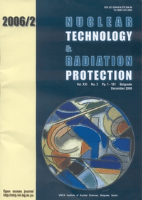
Nuclear Technology & Radiation Protection
Illuminating the path to efficient nuclear technology.Nuclear Technology & Radiation Protection is a distinguished open-access journal published by the VINCA Institute of Nuclear Sciences, Serbia, dedicated to advancing knowledge in the fields of nuclear energy and radiation safety. Since its inception in 2002, the journal has been an essential resource for researchers, professionals, and students, offering a platform for the dissemination of high-quality research that contributes to the safe and efficient use of nuclear technology. With an impressive Q2 ranking in both the Nuclear Energy and Engineering and Safety, Risk, Reliability and Quality categories for 2023, the journal reflects a commitment to excellence and relevance within its scope. It serves as a pivotal forum for sharing innovative findings, addressing current challenges, and contributing to the global discourse on nuclear safety and technology. The journal is indexed in Scopus, enhancing its visibility and impact in the academic community. By facilitating unrestricted access to its articles, Nuclear Technology & Radiation Protection continues to foster collaboration and engagement among scholars in the nuclear science domain.
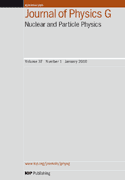
JOURNAL OF PHYSICS G-NUCLEAR AND PARTICLE PHYSICS
Charting New Territories in Nuclear and Particle PhysicsJOURNAL OF PHYSICS G-NUCLEAR AND PARTICLE PHYSICS, published by IOP Publishing Ltd, stands as a premier journal in the realm of Nuclear and High Energy Physics. With an established presence since 1989 and currently converging toward 2024, this influential journal emphasizes groundbreaking research and discoveries in particle physics, fostering the dissemination of knowledge among a global audience of researchers, professionals, and students. Recognized for its high-quality publications, it holds a Q1 ranking in its category for 2023, placing it at an impressive 87th percentile among 87 journals in its field as per Scopus Rankings. The journal's impact is reflected in its esteemed reputation, making it an essential resource for advancing the frontiers of physics. Although it currently does not operate under an open access model, the journal ensures that subscribers receive comprehensive insights into the latest developments and theoretical advances that shape our understanding of the universe.
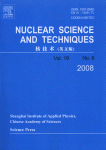
Nuclear Science and Techniques
Exploring the Depths of Nuclear EngineeringNuclear Science and Techniques is a distinguished peer-reviewed journal published by Springer Singapore Pte Ltd, dedicated to advancing the fields of nuclear science and engineering. With an impressive impact factor reflected in its 2023 quartile rankings—Q2 in Nuclear and High Energy Physics and Q1 in Nuclear Energy and Engineering—the journal serves as a vital resource for researchers, professionals, and students alike. Covering a breadth of topics from nuclear physics to energy applications, it offers a platform for innovative research and developments in the nuclear domain. The journal, indexed under ISSN 1001-8042 and E-ISSN 2210-3147, aims to foster scientific exchange and collaboration within the community by publishing high-quality articles that contribute significantly to the field. Committed to maintaining an open-access ethos, it enhances visibility and accessibility of critical knowledge, making it an essential source for current insights and trends in nuclear science.

Radiation Detection Technology and Methods
Bridging Theory and Application in Nuclear PhysicsRadiation Detection Technology and Methods is a prominent academic journal published by Springer Singapore Pte Ltd, dedicated to advancing the field of nuclear and high-energy physics, as well as nuclear energy and engineering. Established in 2017, this journal provides a platform for the dissemination of pioneering research and innovative methodologies in radiation detection technology. As of 2023, it holds a commendable Q2 ranking in both the categories of Nuclear and High Energy Physics and Nuclear Energy and Engineering, underscoring its significance in fostering scholarly discourse within these vital fields. With ISSN 2509-9930 and E-ISSN 2509-9949, the journal aims to cater to a diverse audience of researchers, professionals, and students, emphasizing open access to knowledge. The journal's contributions are particularly crucial for those engaged in the development of safer and more efficient radiation detection techniques, ultimately bridging the gap between theory and practical applications in energy security and health physics. For researchers seeking a dedicated outlet for their work, Radiation Detection Technology and Methods represents an invaluable resource and an opportunity to influence the future of radiation science.
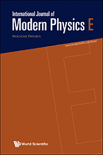
INTERNATIONAL JOURNAL OF MODERN PHYSICS E
Unveiling the Mysteries of the Cosmos Through Rigorous ResearchThe INTERNATIONAL JOURNAL OF MODERN PHYSICS E, published by WORLD SCIENTIFIC PUBL CO PTE LTD, serves as a distinctive platform for the dissemination of high-quality research in the fields of Nuclear and High Energy Physics, as well as Physics and Astronomy. With an ISSN of 0218-3013 and covering a timeline from 1996 to 2024, the journal has established itself within the academic community, achieving a respectable Q3 ranking in its respective categories for 2023, underscoring its commitment to advancing knowledge in modern physics. Although it operates without an open access model, the journal's curated content is accessible to a wide audience of researchers, professionals, and students engaged in cutting-edge physics. Set in Singapore, this journal not only contributes to scholarly discussions but also fosters a global collaboration among physicists, making it an invaluable resource for those seeking to deepen their understanding and contribute to ongoing dialogues in the scientific community.

JOURNAL OF RADIOANALYTICAL AND NUCLEAR CHEMISTRY
Advancing knowledge in radiochemistry and nuclear science.JOURNAL OF RADIOANALYTICAL AND NUCLEAR CHEMISTRY, published by Springer, serves as a vital platform for the dissemination of research in the fields of analytical chemistry, nuclear science, and radiochemistry. With an ISSN of 0236-5731 and an E-ISSN of 1588-2780, this journal has been a beacon of innovation and scholarly communication since its inception, transitioning from converged years of 1977-1979 to its current continuity from 1984 to 2024. Positioned in the Q3 category for analytical chemistry and other related fields such as health, toxicology, and nuclear engineering, it boasts significant standings in the Scopus rankings, reflecting its relevance and impact within these disciplines. The journal emphasizes open access, encouraging broader accessibility to quality research, which is critical for students, professionals, and ongoing global scientific discussions. As a leader in its domain, the JOURNAL OF RADIOANALYTICAL AND NUCLEAR CHEMISTRY is committed to advancing the understanding of radioactive materials, environmental safety, and health applications, ensuring its readers remain at the forefront of emerging trends and discoveries.

Problems of Atomic Science and Technology
Advancing the Frontiers of Atomic Science.Problems of Atomic Science and Technology is a leading journal in the realm of nuclear physics and technology, published by the esteemed Kharkov Institute of Physics and Technology. With an ISSN of 1562-6016, this journal is dedicated to disseminating high-quality research and advancements in atomic sciences, contributing significantly to both academic and practical applications in the field. Although not an open access publication, it ensures rigorous peer review standards to maintain the integrity and relevance of cited works. The journal seeks to provide a vital platform for researchers, professionals, and students who are engaged in the exploration of atomic phenomena, nuclear engineering, and associated technologies. Published from Kharkov, Ukraine, the journal also serves as a bridge for international collaboration and innovation, making it indispensable for anyone looking to stay at the forefront of atomic science research.
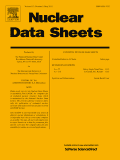
NUCLEAR DATA SHEETS
Illuminating Nuclear Science Through Comprehensive Data.NUCLEAR DATA SHEETS is a premier journal published by Academic Press Inc. Elsevier Science, dedicated to advancing the field of nuclear and high-energy physics. With an impressive impact factor and a distinguished Q2 ranking in the pertinent category as of 2023, this journal is recognized for its significant contributions to the synthesis and dissemination of nuclear data, serving as an essential resource for researchers, professionals, and students alike. The journal has been in continuous publication since 1971, making it a cornerstone of knowledge in the discipline as it converges into 2024. Researchers can explore a plethora of meticulously curated articles that cover the latest findings, theoretical advancements, and experimental results in nuclear data, with the objective of fostering collaboration and innovation within the scientific community. While currently not open access, its publications are accessible through institutional subscriptions, ensuring a wide reach amongst academic and research institutions worldwide. With a high Scopus rank of #10 out of 87 in its field, NUCLEAR DATA SHEETS remains an authoritative source that is instrumental in shaping the future of nuclear physics research.

ATOMIC ENERGY
Catalyzing collaboration in the nuclear research community.ATOMIC ENERGY is a distinguished journal published by SPRINGER, focusing on pivotal advancements and research within the field of Nuclear Energy and Engineering. With an ISSN of 1063-4258 and an E-ISSN of 1573-8205, this journal has been a critical resource since its inception in 1956, serving both historic and contemporary scientific inquiries into nuclear technologies. Currently positioned in Q3 of the Nuclear Energy and Engineering category, ATOMIC ENERGY ranks 49 out of 77 in Scopus, representing a percentile of 37%, highlighting its relevance in the research community. While it is not an open access journal, it continues to draw a diverse readership eager to engage with the latest findings and innovations in nuclear science. The journal’s objectives include fostering collaborative research, sharing expertise, and addressing contemporary challenges in nuclear energy. As such, ATOMIC ENERGY remains an essential platform for researchers, professionals, and students alike, contributing significantly to the ongoing dialogue in the field.